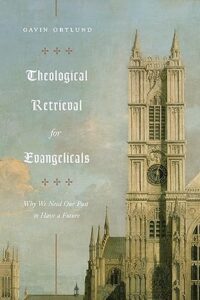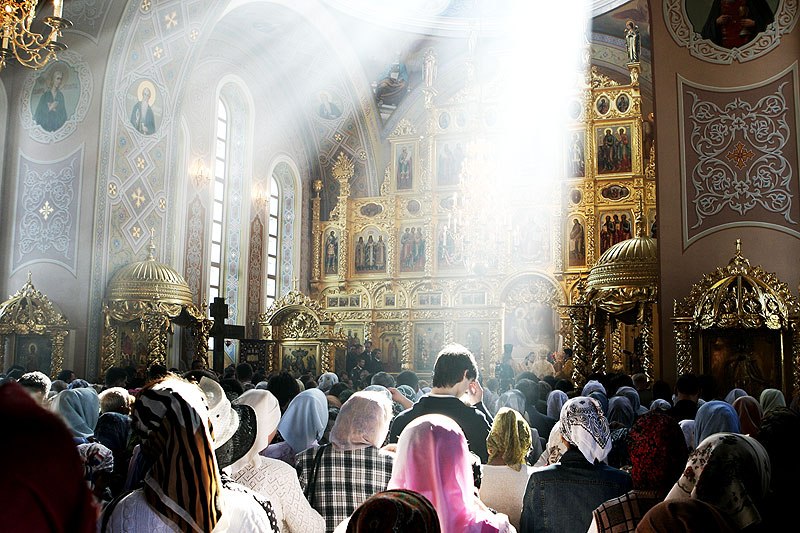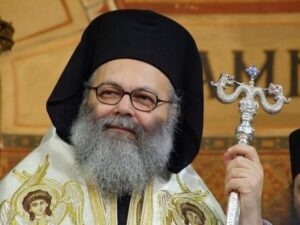
Antique Shop
Antique Shopping Versus Going Home
In recent years growing numbers of Evangelicals have been converting to Orthodoxy. Christianity Today reported on this trend in an October 2023 interview with Bradley Nassif (See Casper; see also pages 46-47 in Gavin Ortlund’s Theological Retrieval for Evangelicals.) Among the reasons for the switch is a desire for a return to the early Church and to the ancient wisdom of the Church Fathers. Many Evangelicals grew up in a tradition that focused primarily on the Bible and gave scant attention to the early Church. Dissatisfied with the shallowness of Evangelical theology, many began studying church history and in doing so discovered the Church Fathers. This shock of discovery led many to swim the Tiber (become Roman Catholic) or cross the Bosphorus (convert to Orthodoxy).
 This trend has not gone unnoticed by Protestants. In response, there emerged an intellectual project known as theological retrieval. One recent example is Gavin Ortlund’s Theological Retrieval for Evangelicals: Why We Need our Past in Order to Have a Future (2019). He wrote the book in order to persuade Evangelicals to remain within the Protestant fold. He employs a two-pronged strategy. First, unlike Fundamentalism which insists on solo scriptura, he points to classical Protestantism’s sola scriptura which drew on historical and patristic sources. Second, he argues that appropriating the Church Fathers can enrich Evangelical theology and help Evangelicals address present-day challenges. (See Keith Mathison’s insightful discussion of the difference between solo scriptura and sola scriptura in The Shape of Sola Scriptura.)
This trend has not gone unnoticed by Protestants. In response, there emerged an intellectual project known as theological retrieval. One recent example is Gavin Ortlund’s Theological Retrieval for Evangelicals: Why We Need our Past in Order to Have a Future (2019). He wrote the book in order to persuade Evangelicals to remain within the Protestant fold. He employs a two-pronged strategy. First, unlike Fundamentalism which insists on solo scriptura, he points to classical Protestantism’s sola scriptura which drew on historical and patristic sources. Second, he argues that appropriating the Church Fathers can enrich Evangelical theology and help Evangelicals address present-day challenges. (See Keith Mathison’s insightful discussion of the difference between solo scriptura and sola scriptura in The Shape of Sola Scriptura.)
Gavin Ortlund is not the only Protestant who has attempted theological retrieval. This reaction to the shallowness of Evangelicalism and its accompanying historical amnesia has been part of Evangelicalism’s recent history. Robert Webber’s Common Roots: A Call to Evangelical Maturity, which came out in 1978, was written to remedy these two weaknesses. Thomas Oden’s After Modernity – What? (1990) described his students’ turning away from modern theology preferring instead the ancient Faith. Reading Webber and Oden helped me embark on a quest for the ancient Faith. This led me to the Oxford Movement and Mercersburg Theology of the mid-1800s. Both were attempts at theological retrieval, one in the Anglican tradition and the other within American Calvinism. While drawing considerable attention, both failed in their attempts to transform their denominations. Thus, the quest for the ancient Faith among Evangelicals is not new but has been going on for decades, if not centuries.
Two Ways of Reclaiming the Past
The theological retrieval project can be likened to antique shopping. Imagine a couple living out in the suburbs, they spend much of their free time consuming social media, and doing much of their shopping at the nearby mega mall or online. One day the modern suburbanites feel a hunger for their roots and for a family tradition to be passed on to their children. So, on the next family vacation, they visit an antiques shop and buy a few century-old pieces of furniture. They bring these traditional furniture home and intermix them with their latest Ikea furniture. They proudly tell their friends and family that they recently recovered their family heritage. In addition, they sign up for 23andMe which traces their family roots to a particular region and even to a particular village. Later, they excitedly share this new-found information with friends and family but when asked when they plan to visit their ancestral village, they reply they are too busy to reconnect with their long-lost relations. So, when one sees the young couple proudly look on their recently-acquired “heirlooms” and hear them enthuse over their rediscovered family lineage one does not know whether to laugh or cry. They are as far removed from their ancestral roots as they were before their antique hunting spree. The point of this parable is to point out the absurdity of Evangelicals’ attempting theological retrieval.
Theological retrieval was not part of the original Protestant Reformation. Theological retrieval is based upon the premise that something has been lost and needs to be brought back. The magisterial Reformers, Luther and Calvin, were acquainted with the Church Fathers. The original Reformers frequently cited patristic sources—often unfortunately cherry-picking patristic sources—in the debates with their Roman Catholic opponents. Thus, they had no need for theological retrieval. It was the later generations of Protestants and Evangelicals who lost their historical roots. Many present-day Evangelicals know little to nothing of the Church Fathers. I did not learn about the Church Fathers from my Evangelical home church. I discovered the Church Fathers on my own as a result of hanging out at the university library. I often took study breaks by browsing the stacks containing books on biblical studies and theology.
Modern-day Evangelicalism’s historical amnesia is largely due to Protestantism’s foundational dogma: sola scriptura. This doctrine combined with a fixation on the scientific study of the biblical text has pushed the Church Fathers to the sidelines and to an ahistorical approach to theology. These are unintended consequence of sola scriptura. Ryan Currie describes how even as recently as 2013, Evangelical seminarians have been admonished to avoid Pre-Reformation theologians and focus on the Reformation and Puritan writings. Despite the fact that both Protestantism and the early Church held the Bible with great respect, there is a palpable difference between the two. A Protestant reading the Church Fathers for the first time will to their surprise find themselves in unfamiliar territory where all the familiar landmarks are missing. I experienced this vertigo when I first read the Church Fathers and studied early Christianity. For years I was drawn to and perplexed by the Church Fathers. This sense of confusion lifted when I came to the realization that the early Church was theologically not Protestant but something else, a separate theological tradition.
This raises the question: If theological retrieval is the attempt to bring back something which was lost, does that not assume that what was lost was something in one’s possession previously? If the early Church was Protestant to begin with, then theological retrieval by Protestants makes sense. However, if Protestantism is a separate tradition from early Christianity, then theological retrieval is really theological expropriation—the taking of something that does not properly belong to you. The problem with theological expropriation is that it can end up in eclecticism, borrowing from a wide range of disparate sources. Unless there is an organizing principle, theological retrieval ends up being a magpie collection of theological tidbits. An example of this unchecked eclecticism can be seen in this bold claim made by Gavin Ortlund:
Likewise, there is an underlying current that, for all its diversity, unites Bernard and Barth, Tertullian and Tolkien, Polycarp and Pentecostalism. (p. 84, Theological Retrieval for Evangelicals).
Joseph Cochran points out this weakness:
Thus, Protestant historians and theologians can craft their own tailor-made traditions. After all, every retriever exercises selectivity and private judgment on what ought to be retrieved and the fallout of this, whether incidental or intentional, could be significant. As Timothy George has put it so well, no one should be ransacking (or cherry-picking) the past to meet present programs. Unfortunately, Ortlund’s project does not anticipate these common barriers and objections to retrieval. [Emphasis added.]
Without an organizing or guiding principle, theological retrieval ends up as theological subjectivism, citing Church Fathers one likes and ignoring those one dislikes. Or as Augustine of Hippo warned:
If you believe what you like in the Gospel, and reject what you don’t like, it is not the Gospel you believe, but yourself.
Guidance is needed for appropriating the Church Fathers. Early Christianity was a period of diverse religious currents, some orthodox and others outright heretical. Just because a Christian writer lived during the early years of Christianity does not mean he was a Church Father. For example, Tertullian is not considered a Church Father by the Orthodox Church despite the fact many non-Orthodox today refer to him as a Church Father. For Orthodoxy, a Church Father is a theologian known for his teachings and his exemplary life. For all his theological brilliance, Tertullian died a Montanist heretic outside the Orthodox Catholic Church. In reading early Christian theology the Orthodox Christian is guided by the Church as to who is a Church Father an d who is not. These internal safeguards help protect Orthodox from questionable sources. Without these guardrails theological retrieval can result in a confused mixture varying in quality and degree of orthodoxy.
Can Theological Retrieval Succeed?
When one surveys the sprawling contours of present-day Evangelicalism , one sees a wide range from high church Anglicans to low church Baptists to freewheeling charismatic non-denominational churches, and more recently, extremist Christian Nationalism. I find it highly unlikely that Gavin Ortlund’s theological retrieval project is going to make a huge difference across the Evangelical spectrum. Evangelical Fundamentalism, the strand of Evangelicalism that stands most in need of theological retrieval, is likely to be hostile to Gavin Ortlund’s project. This is due to the strong anti-intellectual streak in American Evangelicalism. See Mark Noll’s The Scandal of the Evangelical Mind (1995). Rather than exert a wide-ranging influence over Evangelicalism, I anticipate that Ortlund’s theological retrieval project will end up a niche specialty among the wildly overgrown landscape of Protestant theologies. There is nothing in Protestantism to stop a pastor from willfully ignoring Gavin Ortlund’s plea that he study the Church Fathers and church history.
It is unlikely that Gavin Ortlund’s church or his denominational body will reconfigure their theological framework to give greater prominence to the Church Fathers. For Ortlund’s attempt at theological retrieval to succeed, it would eventually need to make its way into the seminaries. I would be shocked but also delighted if a Reformed seminary were to offer patristics as a curriculum track in their degree program.
Gavin Ortlund’s Theological Retrieval is very Protestant in its approach to theology. At the heart of Protestantism is the notion of theology as something self-constructed, not as something received through the traditioning process in the Church. It takes as its starting point the Christian studying the Bible with great care and based on what he finds in the biblical text constructs a theological system to live by. Gavin Ortlund’s switch to the Baptist tradition based on his personal study is a good example of theology as a self-constructed project (See Ortlund 2013). Herein lies the methodological divide between Protestantism and Eastern Orthodoxy. In Orthodoxy, one receives the Faith from the Church and one does theology within the context of the Church. In Protestantism, one constructs theology based upon one’s careful study of the Bible. Protestantism’s sola scriptura creates the space for doing theology independently of the institutional Church. Such a thing is unheard of in Orthodoxy.

Orthodox Liturgy – Ancient worship in today’s world
A Quest for the Church
What prompted many Evangelicals to leave Protestantism for Orthodoxy or Roman Catholicism has been the desire to be part of the one, true, ‘capital C’ Church. Gavin Ortlund’s response is to draw a distinction between the visible, institutionalized church and the invisible body of Christ comprised of true believers. However, it should be kept in mind that the idea of an invisible, non-institutional Church is doctrinal novelty. It is not part of the historic Christian Faith. Luther and Calvin, following John Wycliffe, claimed that the true Church was the invisible Church comprised of the elect (See Omanson). In this way they were able to claim they were part of the church even while in outright schism with Rome. It seems that growing numbers of Evangelicals are finding the doctrine of the invisible church to be wearing thin giving rise to a hunger to be part of the visible ‘capital C’ Church.
Throughout church history, the Church has been understood to be the community of the faithful gathered around the Eucharist under the leadership of the bishop, the successor to the Apostles. This teaching can be found as early as the beginning of the second century in the letters of Ignatius of Antioch. While Gavin Ortlund has much to say about the Church Fathers, he does not say much about this historic understanding. His neglect of the early liturgies and the real presence of Christ’s Body and Blood in the Eucharist is quite telling. He seems understand Christianity as more a system of doctrine than as an eucharistic community. Moreover, his position that the episcopacy is beneficial but not necessary is consistent with his invisible church doctrine even as it is at odds with historic Christianity. To switch from church unity centered around doctrine to church unity centered around the Eucharist marks a step away from Protestant ecclesiology to the ancient Church. When I came to understand how doctrine is intertwined with the Eucharist, my theology underwent a profound paradigm shift. My understanding of Christianity became more organic and coherent. It also ceased to be Protestant.
Icon: Christ the Great High Priest of the Holy Eucharist
For many converts, it was not just the beauty of liturgical worship that drew them to Orthodoxy. It was the historic teaching that the Eucharist is not a symbol but really and truly the body and blood of Christ that was a game changer. If the Lord’s Supper is just a symbol, then it doesn’t really matter which church group you affiliate with. But if Christ’s body and blood is really and truly present in the Eucharist, then church affiliation is hugely consequential. The local ‘small c’ church and the universal ‘capital C’ Church are no longer two parallel realities (as understood in Protestant ecclesiology) but two overlapping realities. I could have read the Church Fathers extensively but that did not equal being in eucharistic fellowship with the Church Fathers. As a Protestant, I could claim an invisible, spiritual unity with the Church Fathers but that did not satisfy the longing for fellowship with them. When I became Orthodox, I sensed a stronger sense of connection with the Church Fathers and the saints of the ages through my partaking of the Eucharist. Through the Eucharist and the ancient liturgies I am linked to the early Church in a very tangible way.

A Family Moving
Running through all this is the desire to return home. For many Evangelicals, adding books by the Church Fathers in their book collection does not cut it. This is the equivalent of antique shopping. In theological retrieval, the Church Fathers function more as decorative accessories than as binding authorities. The alternative to antique shopping is repatriation, migrating back to the homeland. This is a radical move many are not ready to take. An Evangelical converting to Orthodoxy can still take with them many of the lessons learned from Protestantism, however, there are many significant changes in beliefs, attitudes, and lifestyle they will need to embrace if they want to be received into Orthodoxy. (I discussed this in my article: “Crossing the Bosphorus.”)
Unlike the cool, fashionable couple who recently acquired some antiques for their suburban home, the repatriated migrant will find him/herself joyfully welcomed into an ancient castle filled with many ancient pieces of furniture and in which many of the ancient customs still live on today. Rather than gaining a few new antiques, Evangelical converts to Orthodoxy have—to their surprise and joy—come into possession of an ancient patrimony.

John X – Patriarch of Antioch
Orthodoxy’s appeal lies in the fact that Orthodox Church of today can claim direct, unbroken historical continuity with the early Church. See the Antiochian Patriarchate’s listing of bishops which trace back to Acts 13 (St. George Antiochian Orthodox Church and OrthodoxWiki). This is something no Protestant church can claim. This is more than a succession of laying of hands but also a historic succession of celebrating the Eucharist going back to the original Apostles. Many Protestant inquirers find this appealing. They want to be part of the same Church as the Church Fathers. They want to share in the same Eucharistic communion as the early Christians. However, the tension for many Protestant inquirers surface when they realize that Protestant theology is not continuous with the early Church and that Protestantism is out of communion with the early Church. This is the moment of realization that the radical option of repatriation is needed—cutting ties and moving abroad.
In Orthodoxy there is no need for theological retrieval. We are reminded of our roots in the Sunday Liturgy and in the feast days throughout the church year. We recite the Nicene Creed (381) in its original form every Sunday. We use the ancient liturgies of Saint Basil and Saint John Chrysostom. We commemorate the Church Fathers and the Ecumenical Councils in the church calendar. There are visual reminders (icons) of the saints, Church Fathers, and Ecumenical Councils. In addition to expositing on the biblical text of the day, the Orthodox priest will endeavor to bring in a quote or two from the Church Fathers. In the ordinary Greek Orthodox parish I attend, I am exposed to ancient Christianity each and every Sunday. Come and see!
Robert Arakaki
References
Robert Arakaki. “Crossing the Bosphorus.” OrthodoxBridge 15 January 2013. See also Journey to Orthodoxy.
Jayson Casper. 2023. “The Orthodox Church Is More Evangelical Than You Think.” Christianity Today 1 December 2023.
Joseph Cochran. Review: “Theological Retrieval for Evangelicals: Why We Need Our Past to Have a Future” Themelios 45:2
Ryan Currie. Tested by the Cross: Theological Retrieval. ChristOverAll.com
Ignatius of Antioch. Letter to the Smyrnaeans. (See chapters 7 and 8)
Keith A. Mathison. 2001. The Shape of Sola Scriptura. Canon Press.
Mark Noll. 1995. The Scandal of the Evangelical Mind.
R.L. Omanson. 1984. “The Church.” Evangelical Dictionary of Theology. Roger Elwell, editor. Grand Rapids, Michigan. Baker Book House.
OrthodoxWiki “List of Patriarchs of Antioch.”
Gavin Ortlund. 2019. Theological Retrieval for Evangelicals: Why We Need Our Past to Have a Future. Wheaton, Illinois: Crossway Books.
Gavin Ortlund. “Why I Changed My Mind on Baptism.” Bible & Theology – The Gospel Coalition, 8 March 2013.
St. George Antiochian Orthodox Church – Cleveland Ohio. “Patriarch of Antioch.”
Leave a Reply